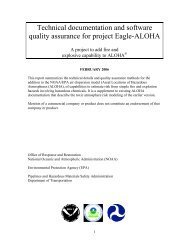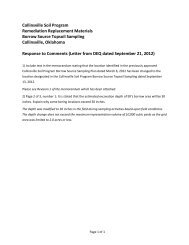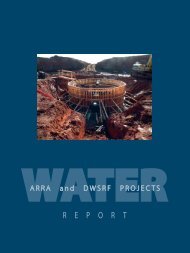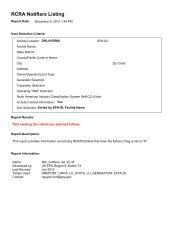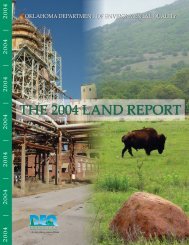Oklahoma Gas & Electric Muskogee Generating Station Best ...
Oklahoma Gas & Electric Muskogee Generating Station Best ...
Oklahoma Gas & Electric Muskogee Generating Station Best ...
You also want an ePaper? Increase the reach of your titles
YUMPU automatically turns print PDFs into web optimized ePapers that Google loves.
<strong>Oklahoma</strong> <strong>Gas</strong> & <strong>Electric</strong><br />
<strong>Muskogee</strong> <strong>Generating</strong> <strong>Station</strong> – BART Determination<br />
May 28, 2008<br />
1.3 BART Requirements<br />
A determination of BART must be based on an analysis of the best system of continuous emission<br />
control technology available and associated emission reductions achievable. The BART analysis<br />
must take into consideration: (1) the technology available; (2) the costs of compliance; (3) the<br />
energy and non-air-quality environmental impacts of compliance; (4) any pollution control<br />
equipment in use at the source; (5) the remaining useful life of the source; and (6) the degree of<br />
improvement in visibility which may reasonably be anticipated to result from the use of such<br />
technology.<br />
Guidelines for making BART determinations are included in Appendix Y of 40 CFR Part 51<br />
(Guidelines for BART Determinations Under the Regional Haze Rule). States are required to use<br />
the Appendix Y guidelines to make BART determinations for fossil-fuel-fired generating plants<br />
having a total generating capacity in excess of 750 MW, but are not required to use the guidelines<br />
when making BART determinations for other types of sources. Because the <strong>Muskogee</strong> <strong>Generating</strong><br />
<strong>Station</strong> has a total generating capacity in excess of 750 MW, the Appendix Y guidelines were used<br />
to prepare the BART determination.<br />
The Appendix Y guidelines for BART determinations identify the following five steps in a case-bycase<br />
BART analysis:<br />
Step 1. Identify All Available Retrofit Control Technologies.<br />
Step 2. Eliminate Technically Infeasible Options.<br />
Step 3. Evaluate Control Effectiveness of Remaining Control Technologies.<br />
Step 4. Evaluate Impacts and Document the Results.<br />
Step 5. Evaluate Visibility Impacts.<br />
A more detailed description of each step is provided below.<br />
Step 1. Identify all available retrofit control technologies.<br />
Available retrofit control options are those air pollution control technologies with a practical<br />
potential for application to the emissions unit and the regulated pollutant under evaluation (70<br />
FR 39164 col. 1). Step 1 of the BART determination requires applicants to identify potentially<br />
applicable retrofit control technologies that represent the full range of demonstrated<br />
alternatives. Potentially applicable retrofit control alternatives can include pollution prevention<br />
strategies, the use of add-on controls, or a combination of control strategies. Control<br />
technologies required under the new source review (NSR) program as best available control<br />
technology (BACT) or lowest achievable emission rate (LAER) are available for BART<br />
purposes and must be included as potential control alternatives. However, EPA does not<br />
5



